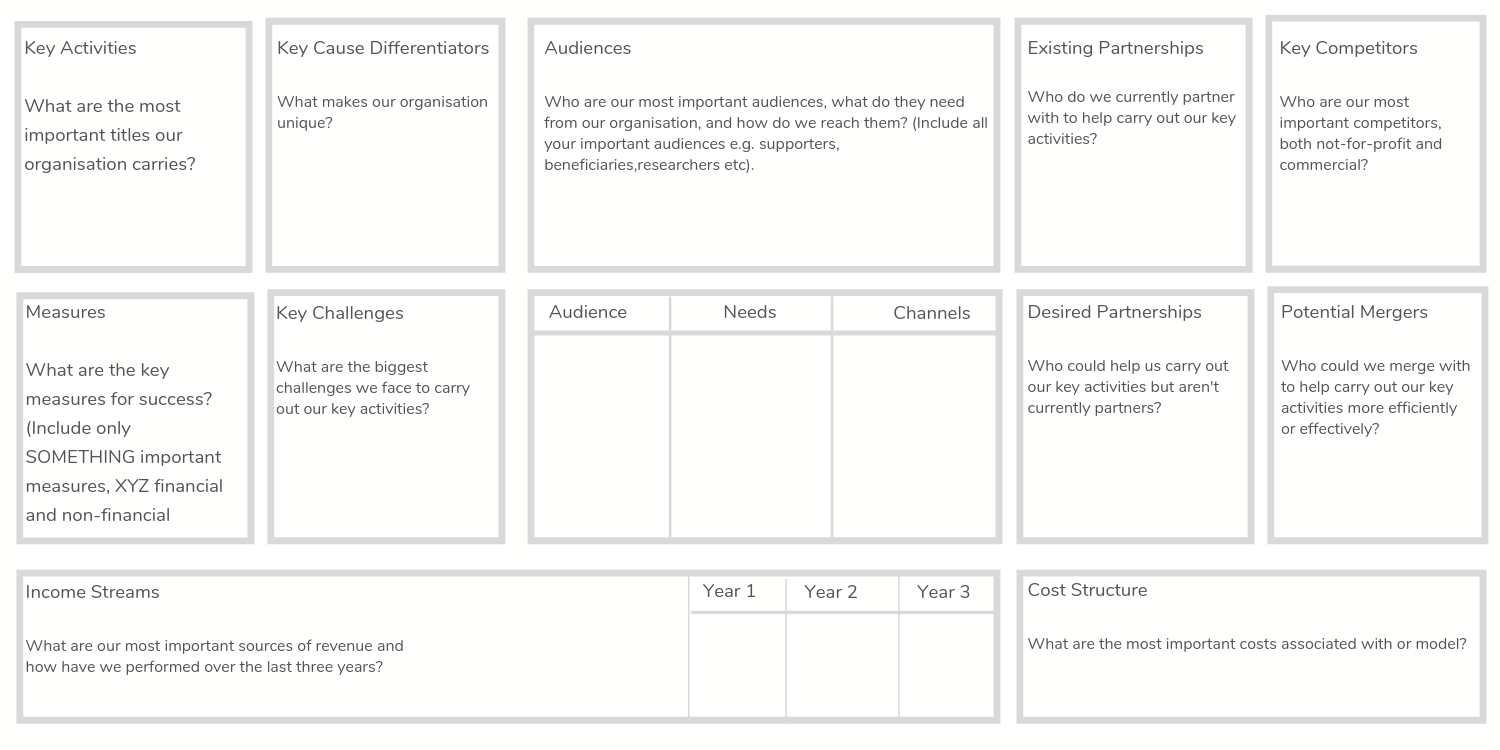The Future Charity Canvas

The Charity Model Canvas is all about future-proofing your charity in a rapidly changing world. Based on Alexander Osterwalder’s Business Model Canvas, a tool used extensively and successfully within the private sector to document, the Charity Model Canvas has been developed with a similar approach but tailored to suit the needs of the the third sector – through additional elements suggested by our research for the Future Charity Report, combined with a clear distinction between customers and other audiences to which a charity has to deliver value. The report and charity model were created in partnership with Manifesto and Massive.
How to use the Charity Model Canvas
Is your organisation’s purpose clear?
If the answer is NO we suggest spending some time defining it before moving forward to the next step.
This could be through creating variants of your purpose and testing them with your different audiences through a series of workshops and focus groups.
Who should be part of the discussion?
The outcomes of the canvas will lead to revelations about where your organisation is now, and the direction it should be going.
By using key stakeholders from different departments, the entire organisation can become united in working towards a common purpose. This collaborative approach can help build consensus and create priorities within the organisation.
The Canvas can also be used to build consensus on a single representation of you as an organisation. This would be through a facilitated session involving key stakeholders, each major function and audience represented. Within this small group, we recommend printing a large copy of the Charity Model Canvas (with space for sticky notes in each box).
You may wish to start with small groups, discuss the differences between each group’s canvas, and then use this to create a consolidated one.
Ready to get started?
Work methodically through each of the areas of the Canvas:
Vision
Describe the purpose of your organisation and what needs to be changed to implement it.
Key Activities
Record important activities your organisation carries out as part of delivering value to beneficiaries, supporters and other stakeholders
Key Cause Differentiators
Consider what makes your organisation unique compared to commercial organisations operating in the same space?
Key Challenges
What are the greatest challenges to delivering your purpose.
Measures
How are you measuring your success at delivering against your purpose?
Landscape
Existing Partnerships
Who do you currently partner with to help carry out our key activities?
Desired Partnerships
Who has the resources to help you carry out your key activities, but isn’t currently a partner?
Key Competitors
Who’s competing for the time, attention and resources of your audiences?
Potential Mergers
Who could you merge with to carry out some, or all, of your key activities more efficiently or effectively?
Audiences
Who are your most important audiences? This might include supporters, beneficiaries, researchers, volunteers, fundraisers etc.
Needs
What do they need from your organisation? How does your organisation benefit them?
Channels
How do you reach and engage them?
Finances
Top Income Streams
What are your most important sources of revenue and how have they performed over the last three years?
Cost Structure
What are the main costs associated with your current model?
What next?
It is important that key stakeholders regularly revisit the organisation’s purpose, and ensure the key factors contributing to it’s success are focused on.
For more insight into why this Canvas is essential to your organisation, take a read of our report on the Future Charity.
Extensive research into the major challenges facing charities in the UK, including extended conversations with people who work in the sector, it describes those challenges in detail and provides suggestions on how to overcome them.
For help completing the model, please reach out.